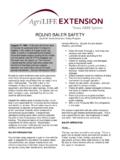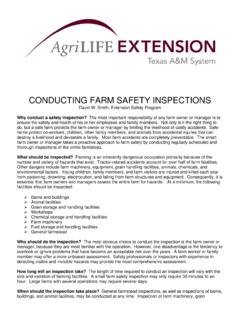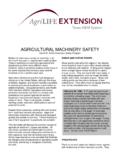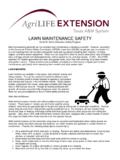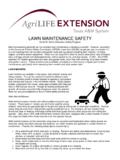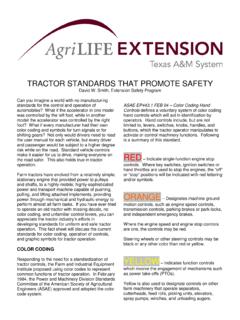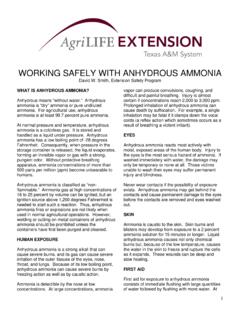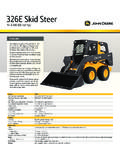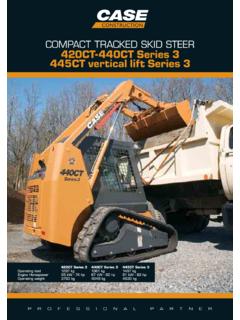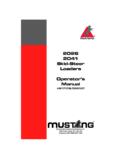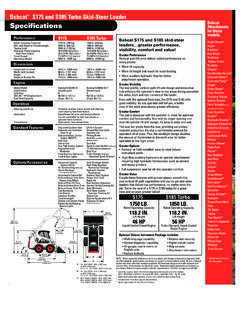Transcription of SKID-STEER LOADER SAFETY
1 SKID-STEER LOADER SAFETY . David W. Smith, Extension SAFETY Program SKID-STEER loaders have been used in the construction and landscaping industry for years. They are also common on dairy, beef, and swine confinement operations. Their small, compact size and maneuverability allow farmers to negotiate narrow alleyways, and to operate under short vertical clearances. This is not possible with most conventional tractors. SKID-STEER loaders are especially useful for removing manure, feed, and other materials from animal confinement areas. CRUSHING HAZARD. SKID-STEER loaders account for numerous serious injuries and deaths each year. Accident factors include the physical design and construction as well as operator error. Typically, the control levers are positioned between the lift arms and in front of the OVERTURN HAZARD.
2 Lift arm pivot points. Operators must enter and exit the LOADER through the front of the machine and over Any self-propelled machine is most stable when its the bucket. Many accidents occur when a foot or center of gravity is kept within its base of stability. hand inadvertently activates the lift arms, LOADER Operating the machine on steep terrain, hauling bucket, or other attachment, pinning or crushing the unbalanced loads that extend beyond the base of operator. This is what led to the fatal accident stability, and making abrupt turns at high speeds described below. can upset the machine, causing it to turn over. Serious skid- LOADER injuries and fatalities result from October 29, 1993. A 26-year-old hog farmer overturns.
3 Was fatally injured when he was caught between September 20, 1996. A 43-year-old worker died the frame of a SKID-STEER LOADER and the lift-arm after he backed a SKID-STEER LOADER over a 6-foot hydraulic cylinder. The victim was alone, using concrete retaining wall. The victim was the LOADER to pile manure in one corner of a hog spreading topsoil by driving toward the wall with confinement building. The LOADER 's rollover a fresh load in the bucket, depositing the soil protective structure (ROPS) had bee removed near the wall, then backing up and dragging the to permit operation under the 6 to 6 foot bucket to spread the soil. At the time of the ceiling of the building. The lift-arm support incident, he approached the edge of the work could be used only when the lift arms were fully area, turned the LOADER around and backed raised.
4 The LOADER stalled in front of and facing toward the wall, dragging the bucket on the the manure pile with the bucket raised, ground. The left rear tire went over the wall preventing the victim from dismounting through followed by the right rear tire. The machine the front of the machine. As he attempted to struck the ground rear end first, coming to rest climb over the side of the machine, he on its left side. The victim, who was not wearing unintentionally hit the lift-arm control lever, a seat belt, remained inside the cab but came causing the lift arms to drop and crush him out of the operator's seat. Source: Missouri against the frame. Source: Minnesota Department of Health. Department of Health. MAINTENANCE HAZARD raised position while the controls are unattended.
5 Newer SKID-STEER loaders are equipped with pin-type The skid- LOADER is basically a power source which supports or strut-type supports that can be engaged operates a front-end LOADER implement. Several while sitting in the operator's cab. accidents have occurred from falling LOADER arms and buckets, while the operator is performing Interlocked Controls maintenance in or around the LOADER bucket. Operator negligence, failure to block up or secure These systems require the operator to be properly lift arms, and bypassing automatic SAFETY switches positioned and restrained before the SKID-STEER are significant SAFETY hazards which lead to LOADER can be used. Some devices require that the numerous injuries. seat belt be connected.
6 Other interlock controls detect when the operator leaves the seat and shuts February 7, 1995. A 37-year-old farmer died down the machine, much like modern riding lawn after he was struck by a falling SKID-STEER LOADER mowers. Other models include a SAFETY restraint bucket. The victim had used the LOADER for bar that must be lowered in front of the operator chores and parked it in an open garage without before the SKID-STEER LOADER will start, much like the cleaning accumulated mud, snow, and manure SAFETY restraint systems on roller coasters. from the foot-operated lift-arm and bucket controls. When the victim shut down the Seat Belts machine and exited from it, he stepped on the lift-arm control, moving it to the lift position.
7 The Seat belts protect the operator in several ways. debris then froze, locking it in place. After about When worn on SKID-STEER loaders equipped with an hour, the victim returned, entered the LOADER ROPS, seat belts restrain the operator within the and started the engine. The lift arms rose until zone of protection in case of a rollover. If seat belts the bucket contacted the header over the are part of the SAFETY interlock system, they protect garage door. The victim shut down the operators from being caught and crushed between machine, dismounted, knelt on the ground the lift arms and frame. The seat belt will also keep under the raised bucket in front of the machine, the operator from reaching out of the cab or from and began cleaning the frozen controls with a being jostled out of the cab in rough terrain.
8 Pry bar. While cleaning, he unintentionally moved the lift-arm foot pedal control to the down ROPS and Side Screens position. The lift arms suddenly moved down, pinning the victim between the bucket and Roll-over protection structures and screens protect frame of the machine. The interlock system for the operator from being thrown from and crushed by the lift-arm control had been defeated by a the SKID-STEER LOADER during a rollover. Usually, the glove that was jammed into the linkage ROPS is part of the enclosed cab design, and connected to the seat belt. Source: University contains side and rear metal grate screens to of Iowa. prevent the operator's hands, head and other body parts from extending into the area between the lift arms and frame.
9 MACHINE SAFEGUARDS. SAFETY TIPS. Using and maintaining manufacturer-installed SAFETY devices will eliminate many skid- LOADER injuries and Pre-operation Check fatalities. Occupational SAFETY and Health Administration (OSHA) regulations and industry You actually reduce the risk of injury by maintaining standards encourage installation and use of these the SKID-STEER LOADER in good working condition, SAFETY devices. Common SKID-STEER LOADER SAFETY thereby limiting the number of times you enter and features include lift arm supports, interlocked exit the machine. Before you start a SKID-STEER controls, seat belts, and ROPS. LOADER , you should check: Lift Arm Supports Fuel and oil Hydraulic fluid Lift arm supports are provided or recommended by Cooling system fluid the manufacturer when it is necessary to work or Operator cab, seat belt, and seat bar move around the machine with the bucket in a Lift arm and cylinder pivot points SAFETY interlock systems Never disable or remove guards, shields, or other Tires SAFETY devices unless specified to do so in the operator's manual.
10 Make sure to set the parking Repair any hydraulic system leak immediately. A brake and lower bucket when working around the leaking hydraulic system may cause the lift arm to SKID-STEER LOADER . If the machine cannot be lower rapidly, causing injury to you or other workers, serviced with the bucket on the ground, use the lift and can damage property. arm supports. Read, understand, and follow the operator's manual Inform all workers of any ongoing maintenance and and understand the meaning of all warning decals keep children away from the work area. Never on the machine. allow a child to sit in the cab while you are working on the SKID-STEER LOADER . Operation OSHA REGULATIONS. SKID-STEER LOADER operation should be restricted to those who have read the instructors manual The following OSHA regulations apply to motor carefully, and who understand machine SAFETY vehicles, mechanized equipment, and marine features.

